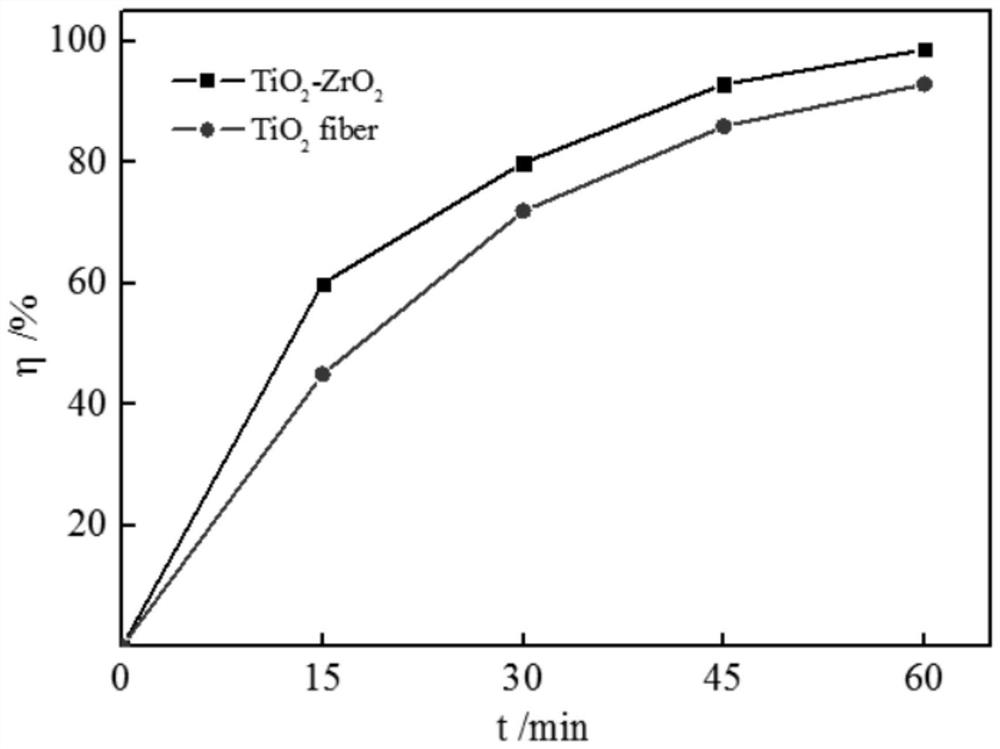A preparation method of photocatalytic composite fiber with strong adsorption
A composite fiber and photocatalytic technology, which is applied in the field of preparation of photocatalytic composite fibers, can solve the problems of weak adsorption effect, low specific surface area, and no obvious interface.
- Summary
- Abstract
- Description
- Claims
- Application Information
AI Technical Summary
Problems solved by technology
Method used
Image
Examples
Embodiment 1
[0036] TiO with strong adsorption 2 -ZrO 2 Preparation of photocatalytic composite fibers:
[0037] Take 0.4g of carbon spheres with a particle size of 400nm-440nm and add it to an ammonia solution containing 0.8g of zirconium chloride and pH=11, take it out after a hydrothermal reaction at 200°C for 10 hours, and place the obtained sample in 6g of butyl titanate Immerse in a solution composed of 4g of absolute ethanol, and dry for 48 hours at room temperature;
[0038] Add 1.2g of spinnable polymer PVP to 8g of ethanol solvent, add 9g of butyl titanate and 1.8g of buffer glacial acetic acid, stir evenly, then add 0.6g of the obtained particles, stir for 30min, and ultrasonically disperse for 30min;
[0039] Put the obtained solution into the propulsion pump, adjust the electrospinning voltage to 30kv, the propulsion speed to 0.037ml / min, the receiving distance to 30cm, the spinning temperature at 45°C, and the humidity at 50%, and perform electrospinning to obtain the precu...
Embodiment 2
[0042] TiO with strong adsorption 2 -Y 2 o 3 Preparation of photocatalytic composite fibers:
[0043] Take 0.8g of carbon spheres with a particle size of 560nm-600nm and add them to an ammonia solution containing 1.6g of yttrium nitrate and pH=11, take them out after hydrothermal reaction at 180°C for 14 hours, and place the obtained sample in 8g of titanium isopropoxide and Immerse in a solution composed of 2g of glacial acetic acid, and dry at room temperature for 24 hours;
[0044] Add 2.4g of spinnable polymer polysulfoneamide to 12g of DMF solvent, add 5g of titanium isopropoxide and 0.6g of glacial acetic acid, stir well, then add 1.2g of the obtained particles, stir for 40min, and ultrasonically disperse for 20min;
[0045] Put the obtained solution into the propulsion pump, adjust the electrospinning voltage to 25kv, the propulsion speed to 0.025ml / min, the receiving distance to 18cm, the spinning temperature at 10°C, and the humidity at 10%, and perform electrospin...
Embodiment 3
[0048] ZnO-ZrO with strong adsorption 2 Preparation of photocatalytic composite fibers:
[0049] Take 0.6g of carbon spheres with a particle size of 480nm-520nm and add it to an ammonia solution containing 1.0g of zirconium nitrate and pH=9, take it out after a hydrothermal reaction at 190°C for 12 hours, and place the obtained sample in 6g of zinc nitrate and 3g of water Dipping treatment in the formed solution, drying at room temperature for 24 hours;
[0050] Add 1.5g of spinnable polymer PVP to 10g of ethanol solvent, add 6g of zinc sulfate and 2.5g of glacial acetic acid, stir evenly, then add 0.7g of the obtained particles, stir for 30min, and ultrasonically disperse for 20min.
[0051] Put the obtained solution into the propulsion pump, adjust the electrospinning voltage to 5kv, the propulsion speed to 0.005ml / min, the receiving distance to 5cm, the spinning temperature at 30°C, and the humidity at 30%, and perform electrospinning to obtain the precursor fiber;
[00...
PUM
| Property | Measurement | Unit |
|---|---|---|
| particle diameter | aaaaa | aaaaa |
Abstract
Description
Claims
Application Information
 Login to View More
Login to View More - R&D
- Intellectual Property
- Life Sciences
- Materials
- Tech Scout
- Unparalleled Data Quality
- Higher Quality Content
- 60% Fewer Hallucinations
Browse by: Latest US Patents, China's latest patents, Technical Efficacy Thesaurus, Application Domain, Technology Topic, Popular Technical Reports.
© 2025 PatSnap. All rights reserved.Legal|Privacy policy|Modern Slavery Act Transparency Statement|Sitemap|About US| Contact US: help@patsnap.com

